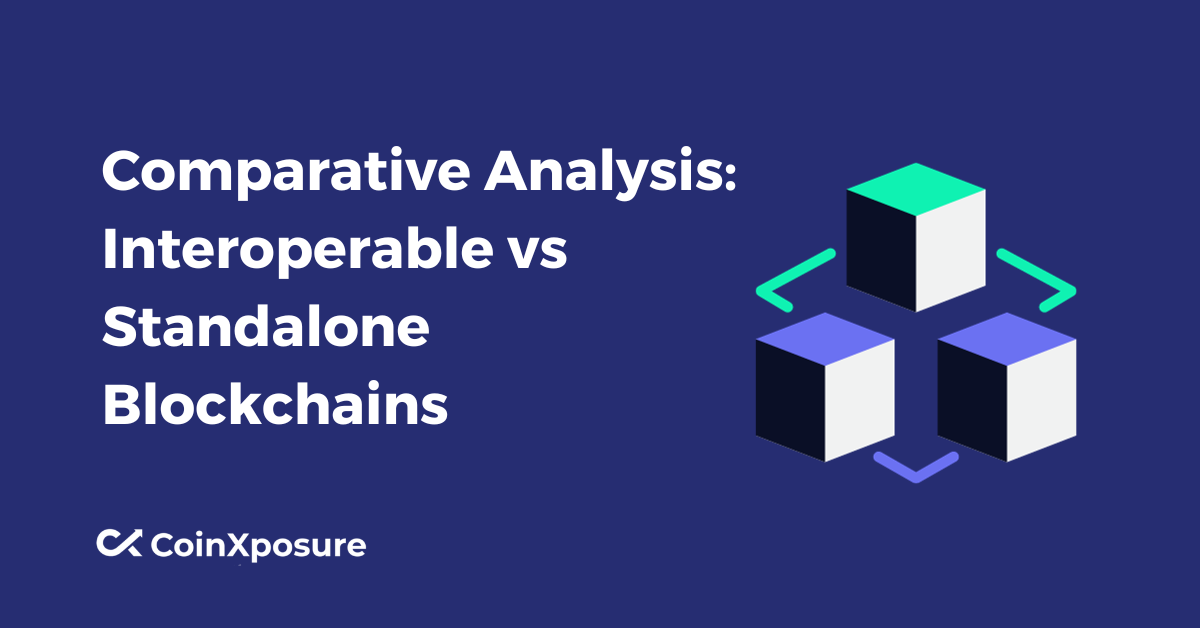
Comparative Analysis: Interoperable vs. Standalone Blockchains
The differences between interoperable blockchains and standalone blockchains are even more glaring as more people consider the advantages of one over the other.
This article provides a comparative analysis of interoperable blockchains and standalone blockchains.
In the past few years, blockchain technology has gotten much attention. This is because it is decentralized and could be used in many different businesses.
But it’s still not widely used in many fields, especially the banking sector, because of some problems.
Most people agree that interoperability is the most important problem. Most blockchains can’t talk to each other or share info, which limits the uses and benefits they could have.
The idea of blockchain collaboration is getting more and more attention as more fields are ready to use blockchain technology.
Before we say any more, let’s delve into the basics and understand what interoperable and standalone blockchains mean.
What are Interoperable Blockchains?
Blockchain interoperability means that different blockchains can easily talk to each other and share data. Putting the idea into action is more challenging than it sounds.
This is because a lot of blockchains were made to work on their own. Because of this, they usually don’t work with other systems, like blockchains.
How Interoperable Blockchains Work
There are only so many ways to make blockchains work with each other because each one is different.
Instead, engineers and people who work on blockchain have created several tools and methods that solve the problem from one chain to the next.
These tools may be different in what they do and how they work, but they all have one thing in common: they don’t let you connect blockchains to third-party platforms.
A critical part of blockchain technology is freedom, which is why they do this. This is a rundown of some of the most well-known blockchain interoperability tools and how they do their jobs.
- Oracle
- Sidechains and parachains
- Atomic swaps
- Cross-chain Bridges
Oracle
Oracles are smart contract mechanisms that allow a blockchain to communicate with the outside world. They can send data from the outside world to the blockchain or vice versa.
Nonetheless, they are far more capable. They can also relay information from one blockchain to another, allowing for interoperability. Cross-chain oracles include Chainlink and the Band protocol.
Sidechains and Parachains
Sidechains are created from a main blockchain and are intended to communicate with it in both directions. A sidechain is a distinct entity with its token system, consensus mechanism, and way of operation.
It benefits the parent chain by taking care of certain of its functions, freeing up space for more efficient operation.
Polygon (MATIC) is one such sidechain project. It operates as a layer-2 blockchain and a sidechain on the Ethereum network.
Parachains, like sidechains, are independent blockchains linked to a main chain. A key distinction is that parachains can interact with one another in addition to the parent chain.
This contrasts sidechains, which can only communicate with the parent chain. As a result, parachains are more interchangeable than sidechains.
Projects that support parachains include the Polkadot and Kusama ecosystems.
Atomic Swaps
An atomic swap (or atomic cross-chain transaction) is a peer-to-peer switching mechanism that exchanges assets from one blockchain for assets from another.
Smart contracts manage the entire process, which is entirely decentralized. The entire procedure is also finished within a set time range.
The transaction is automatically canceled if that period elapses and the contract criteria are unmet.
Cross-chain Bridges
A cross-chain bridge is a feature that allows tokens to be ‘bridged’ from one blockchain to another. It is one of the most significant tools for blockchain interoperability.
Most bridges work by locking or burning tokens on one blockchain and releasing an equal number of tickets on the other.
To accomplish their goal, several cross-chain bridges employ a wrapping mechanism. They encapsulate the value of one token in another and allow that token to be utilized in new ways.
Wrapped BTC is one such example. Although it is redeemable for BTC 1:1, it is an ERC-20 token and may thus be used on Ethereum-based protocols. That is the significance of blockchain interoperability.
Other cross-chain bridges, such as the Celer network, transmit tokens from one blockchain to another using liquidity pools.
Bridges like these can create profit potential for investors willing to supply liquidity to enable transactions.
That said, let us get down to the benefits of interoperable blockchains.
Benefits of Interoperable Blockchains
Interoperable blockchains have numerous advantages, of which we will look at a few here. They include;
- Increased scalability for crypto projects
- Potential for mainstream adoption
- Increased decentralization
Increased Scalability for Crypto Projects
Blockchain scalability refers to a cryptocurrency’s ability to grow and handle more transaction volume than it is accustomed to.
Scalability is one of the most desirable features of a coin since it indicates that it is ready for widespread adoption.
Blockchain interoperability aids in this by ensuring that a token is not constrained by the restrictions of the blockchain upon which it is developed.
Take, for example, the wrapped BTC situation. Bitcoin can only handle roughly five to seven transactions per second (TPS).
However, when packaged as an ERC-20 token, its TPS increases, potentially reaching 100,000 when Ethereum’s modifications are completed.
Potential for Mainstream Adoption
If most of the world embraces cryptocurrency, it will likely not be on a single blockchain.
As a result, blockchain interoperability assures that communication between blockchains is easy, regardless of how many there are.
This communication will ensure that crypto assets have additional use cases, stimulating the growth and spread of blockchain technology.
Increased Decentralization
Decentralization is central to cryptocurrency. That is what interoperability guarantees.
There is a provision for trustless transactions free of intermediaries through the various protocols and techniques we have described. It also assures that no single chain controls all crypto transactions.
People can freely migrate assets from one chain to another, spreading money and technology along the way because there is no need for centralized supervisors.
This also promotes healthy rivalry between blockchains. People and projects, after all, cannot become stuck on a blockchain.
If a blockchain fails to meet expectations, projects can transfer to another. DeGods and Y00ts were recently migrated from Solana to Ethereum and Polygon.
Challenges of Interoperable Blockchains
- Transaction limitations
- Incompatibility of blockchains
- Hacks
Transaction Limitations
Some connected blockchains are only as fast as the slowest member during high traffic.
If transactions become congested on one of the blockchains, it may cause a ripple effect that spans all blockchains connected to that one. This will significantly slow things down.
Incompatibility of Blockchains
There may be problems when two blockchains with different ways of working and tokenomics need to do something together. This is especially true when it comes to the way blockchains handle trust.
For instance, many people think the Proof-of-Work consensus method is the safest. If someone believes this, they might want to avoid connecting Proof-of-Work assets to a blockchain that uses Proof-of-Stake.
Hacks
The security risks of storing assets across different blockchains can be enormous, opening the door to hackers and potential fund loss.
Hackers are continuously exploring existing blockchain bridges for flaws, and they are frequently successful.
Many of these breaches have originated from multi-signature security setups or proof-of-authority consensus processes, which are centralized and significantly more vulnerable.
What are Standalone Blockchains?
Standalone blockchains do not have a direct definition, but they can be seen as blockchain technology that does not allow for collaboration between blockchains.
Standalone blockchain is the direct opposite of interoperable blockchain in that each blockchain works independently without connecting with other blockchains.
A standalone blockchain’s degree of connection can range from sharing as little as developer toolkits to sharing as much as validator sets, finality gadgets, and states.
No objectively superior strategy exists, but each optimizes for differing degrees of shared security guarantees and speed/capacity.
Up next, we will take a look at some standalone blockchain projects;
Standalone Blockchain Projects
Here are some examples of blockchain projects that work independently;
- Polkadot
- Cosmos
- Avalanche
- Polygon
Polkadot

Polkadot was one of the first standalone blockchain projects. It was made to serve application-specific blockchains that share a single global state.
In Polkadot architecture, application-specific blockchains (called “parachains”) share computing and consensus resources with an underlying blockchain whose main job is to keep the world state consistent.
Cosmos

Cosmos SDK is a collection of tools that provide out-of-the-box consensus and execution, allowing anyone to build their own PoA/PoS blockchain.
Unlike the other blockchain projects, Cosmos is predicated on the assumption that smart contract-based virtual machines have limited flexibility, sovereignty, and performance.
As a result, rather than creating a single virtual system on which numerous apps can run, Cosmos encourages and makes it easier to create distinct blockchains for each use case.
This framework provides application developers flexibility regarding architecture, language, etc.
Avalanche

Avalanche is a blockchain ecosystem authenticated by numerous groups of nodes (called subnets).
Subnets can use any consensus method, including variations on Avalanche’s innovative repeating random subsampling-based consensus.
Each blockchain in a subnet shares computational and consensus resources but ultimately maintains its state, with no concept of a shared global state.
Polygon

Polygon is the latest blockchain project to unveil out-of-the-box application-specific blockchains, known as supernets.
Polygon, like the Cosmos SDK, features a modular structure called Edge that allows the building of standalone blockchain networks.
Users can use the framework to deploy either shared security or sovereign blockchains.
Both chains preserve independent states; however, shared security chains use a shared group of validators, whereas sovereign blockchains use their own.
Final Thoughts
We have walked through what interoperable and standalone blockchains are and have different speculations.
However, it is good to note that users on one major public blockchain can easily transact on other major public blockchains once interoperability among the major public blockchains is established.
This will enable new functionality, including payments, smart contracts, and data storage.
